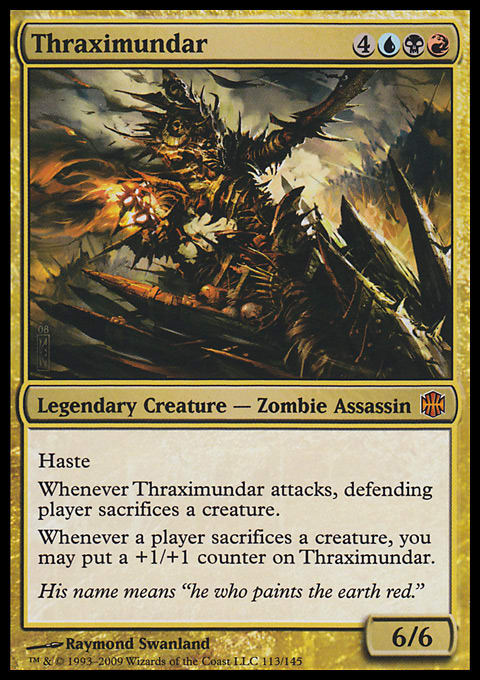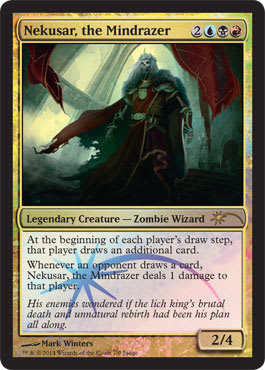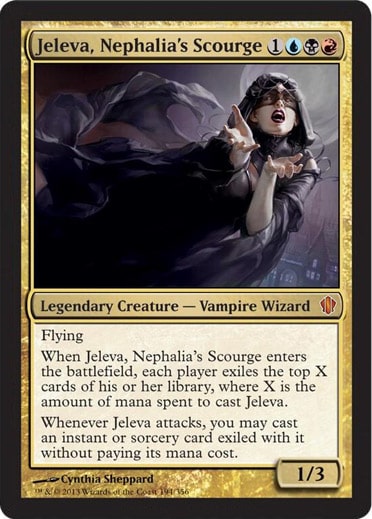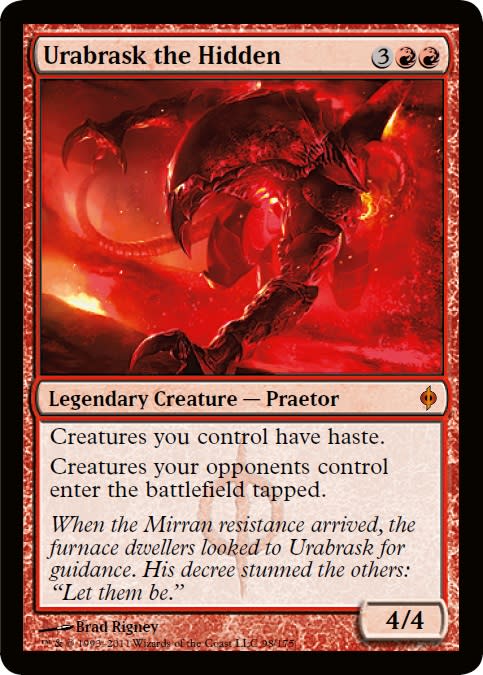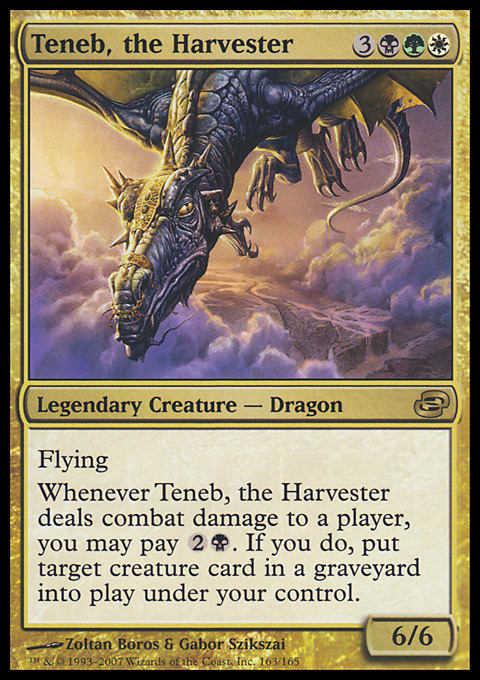This article is a mix of deck tech and design philosophy. One of the ways I've maintained diversity among my decks, and an essential part of my design philosophy, has been making the effort to use cards that are uniquely synergistic or flavorful with that deck, even if it means cutting a more powerful or effective card. The question I always ask when cutting a card is, “If I don’t use it here, where else can I use it?” If the answer is, “Nowhere,” it usually stays in the deck, regardless of power level. I’ll give you some examples of what I’m talking about, starting with the diversity among my Grixis decks. I should explain that I really hate seeing Commander decklists, so instead of posting lists here, I’m giving you links to the decks at TappedOut.net. You can look at the decklists there, but more importantly, you can playtest them to see how the pieces fit together, and the links will be updated as I evolve the decks.
At the end, I will also give a complete list and description of all of my Commander decks. If you'd like me to talk about a particular deck in a future article, or if you’d like to see a list, let me know!
Grixis Gorillas
I wrote about my first two Grixis decks here, and here. You can find the full lists on TappedOut.Net here and here. Thraximundar is one of my headliner decks: the strongest, flashiest decks that always get first priority when I’m finding homes for new cards.1 It just drops bombs all day, often wins with a few quick swings of Thrax himself, and has a serious recursion package that culminates in recasting Cruel Ultimatum every turn. Thrax is all power, all the time, which means he doesn’t have weak cards, although I do keep a copy of Veilstone Amulet in there. It works pretty well with a hasty commander (by casting him, you guarantee that he can't be targeted that turn), and it can occasionally turn an instant into a de facto counterspell. I'm often tempted to replace it with something more proactive and versatile, but then I remember that if I don’t use it in Thrax, I probably won’t use it anywhere. I also added Assault Suit recently because it’s a cute play with Thrax, and it wouldn’t see play anywhere else.
When I made my second Grixis deck, it was very important to me that it played differently than Thrax. I built the deck around Planeswalkers and quickly concluded that Thrax was too powerful to serve as the commander because he usually killed everyone before my Planeswalkers could do anything interesting. That’s why I put the more flavorful but much less powerful Tetsuo Umezawa at the helm—and also took out Cruel Ultimatum. The result is a Nicol Bolas Super Friends deck that can build up to a pretty dominant board position and has an unconscionable number of shenanigans,2 but it isn't in any way similar to Thrax. The unique mechanical focus on Planeswalkers and proliferation means that it not only contains cards that wouldn’t make the cut anywhere else (Ring of Three Wishes over Demonic Tutor for example), but it also plays differently than any of my other decks.
New Blood
Then came Commander (2011 Edition), with two new legends for each shard. I immediately fell in love with Jeleva, Nephalia's Scourge and the whole casting-cost-matters mechanic, and I was determined to build around her, but the precon deck was tightly focused on Nekusar, the Mindrazer, so it was easier to build him first. However, there were already a couple of Nekusar decks in my meta. I didn’t want to build a deck that felt the same as another deck in my group (which is a pretty common casual/Johnny deck-building ethic), but I also hated the way Nekusar with multiple Wheel of Fortune effects felt like a combo deck. I made a conscious decision to avoid any mass-draw effects, replacing them with a small discard suite. The result was an underpowered deck (TappedOut link) that combined a mild defense (e.g. Propaganda, Stuffy Doll, Illusionist's Gambit) with the knowledge that my Howling Mine effects were strengthening other opponents. That lowers my threat profile enough that I can whittle down everyone else’s life totals without becoming anyone’s primary threat. By the time we reach the late game, most people are low on life, and I can finish them off with a little bit of discard/Megrim action or Price of Knowledge. Unlike Thrax or Tetsuo, Nekusar doesn’t have the raw power to take over a table, but that can make the thrill of navigating a path to victory all the sweeter, and I think he has yet to lose a game (maybe Bruce was on to something with that “quiet guy” malarkey).
Even though Nekusar is quite focused mechanically (everything is either draw-related, discard-related, or please-don’t-kill-me-related), there are a couple of pet cards. Pain Magnification does nothing immediately and doesn’t interact with much in the deck, as I dish out damage mostly in 1s and 2s, but I like the way it encourages people to send their beats elsewhere—like a satanic Edric. Skull Rend is inefficient both in terms of discard and damage, but that art is so disturbingly awesome I’ve always wanted to play it. Finally, Talon of Pain has a lot of potential with Nekusar, but it has almost no impact on the board in the first turn, and it’s too expensive to be a top-line cockroach. I should replace it with something stronger, such as Bloodchief Ascension, but if I don’t use it in Nekusar, where am I going to use it?
Building a fourth Grixis deck was a strain even for me, but I found the trick was to build around Jeleva single-mindedly, creating a deck (TappedOut link) that would be absolutely useless if it were commanded by anyone but her. The plan is to cast and recast her, attack fearlessly, and use instants and sorceries over any other card type. It can struggle to win with just the cards on top of my deck, but it can take over a multiplayer game with a little bit of help from my opponents’ strongest spells. Many of my spells will either bounce or sac Jeleva—so that I can bring her out again quickly—or will scry to give me the best shot at revealing bombs when I cast her again. Some of the unique cards I use here are Ritual of the Machine (it’s not much of a sac outlet, but it totally takes people by surprise) and Misinformation. Yes, Misinformation! I tried using it in a mill deck for years, but it never quite worked; now I can take the best sorceries in my opponent’s graveyard, put them on top of that player’s library, and cast them with Jeleva. Weird cards for unique decks: It’s the Johnny way!
A Rose by any other Theme . . .
That brings me to Marchesa, the Black Rose. You have to hand it to Wizards: They don’t make many shard legends these days, but when they do, they hit it out of the park. Marchesa is the third Grixis commander in a row that made me fall head-over-heels in love, and she is totally different than anything we've seen before. There were two problems for me though:- The kind of creatures I want to use in Marchesa are the kind of enters-the-battlefield all-stars that I already use in other decks. If I’m only using Marchesa to recur Mulldrifter, Oxidda Scrapmelter, and Mistbind Clique, why build another deck instead of just adding her to Thrax?
- My buddy Earl made a Marchesa deck right away, and it was exactly the kind of deck that I wanted to make, only better.
Earl found the most obscure +1/+1 counter creatures in the history of the game and combined them with a near-suicidal disregard for his own life total, so that his dudes always gained the dethrone bonus and always came back at the end of turn. It was a dark masterpiece, and I didn’t think I could do anything that wasn’t a pale imitation of his. As a casual player, if I can't take a card and make it my own, I don’t want to build the deck.
Eventually, I realized that Earl was having so much fun with Marchesa that I needed to join the party anyway, but I also found what I hope is a sufficiently different angle that I’m not just net-decking Earl. He was primarily using life manipulation to ensure his creatures gained the dethrone ability, and if they were killed, Marchesa would bring them back. My version (TappedOut link) focuses more on casting dudes with their own +1/+1 counters and saccing them for value—so, for example, I use Stingmoggie instead of the more popular and generally superior Oxidda Scrapmelter. If they can attack and pick up additional counters, so much the better, but I didn’t want to be relying on dethrone to fuel my shenanigans. I also wanted to do more stealing—Marchesa will actually bring stolen creatures back to her side of the board if they die with +1/+1 counters. Conquering Manticore is a total badass in this capacity, and Mark of Mutiny will always have a home here.
Conclusion
If you're new to Commander, you probably just want to know how to build a winning deck, but when you’ve been at it for a while, the biggest challenge is not power, but establishing a unique identity for each deck. When I meet a new player and see his or her Thrax deck, I want to see the ways his or her deck is different from mine and show off the ways my deck is different from his or hers. When I play Nekusar, I don’t want the table to groan because someone played his or her Nekusar deck in the last game and my deck plays exactly the same way. When I play Jeleva, I want to know that the experience will be different than playing any of the other decks I brought with me that day. So I encourage all of you to build around your commander as much as possible, throw away the staples and the powerhouses (within reason), and focus on making bad cards good through the unique synergies they have with other parts of your deck.
Finally, as promised, I have documented my disturbing deck-building psychosis for you. Let me know what decks you'd like me to spotlight in the future.
Black (5 decks) — Xiahou Dun, the One-Eyed (Braids, Cabal Minion, I mean, Smokestack control); Mirri the Cursed (Vampire tribal aggro); Sheoldred, Whispering One (Phyrexian-themed good stuff); Mikaeus, the Unhallowed (Tombstone Stairwell); Erebos, God of the Dead (The Blackest Deck in the WorldTM)
White (1) — Jareth, Leonine Titan (midrange good stuff)
Green (2) — Molimo, Maro-Sorcerer (midrange); Omnath, Locus of Mana (landfall, Zendikar block-ish)
Red (2) — Akroma, Angel of Fury (The Mountains Win Again); Urabrask the Hidden (aggro)
Blue (1) — Arcanis the Omnipotent (control)
Golgari (2) — Glissa, the Traitor (commander-centric artifact/Planeswalker control); Skullbriar, the Walking Grave (commander-centric aggro)
Orzhov (2) — Vish Kal, Blood Arbiter (good-stuff control); Athreos, God of Passage (commander-centric extort)
Rakdos (2) — Olivia Voldaren (commander-centric); Rakdos, Lord of Riots (commander-centric fatties)
Dimir (3) — Lazav, Dimir Mastermind (Korean-only, commander-centric good stuff); Mirko Vosk, Mind Drinker (mill); Ramses Overdark (commander-centric Assassins)
Selesnya (1) — Krond the Dawn-Clad (commander-centric enchantments)
Gruul (1) — Ruric Thar, the Unbowed (commander-centric aggro/midrange)
Simic (1) — Edric, Spymaster of Trest (aggro/hand size matters)
Boros (1) — J.K. Rolling (Swordless Voltron/metalcraft)
Azorius (1) — Isperia the Inscrutable (wings-themed)
Izzet (1) — Niv-Mizzet, Dracogenius (If I Blink, You’ll Miss It)
Bant (0) — TBD (Jenara Tiny Leader, counter control?)
Jund (2) — Kresh the Bloodbraided (commander-centric aggro); Shattergang Brothers (commander-centric control)
Naya (1): Gahiji, Honored One (tokens)
Esper (2) — Sharuum the Hegemon (technically noncombo artifacts); Oloro, Ageless Ascetic (life-gain control)
Grixis (5) — Thraximundar (Grixis Gorillas); Tetsuo Umezawa (Planeswalker control); Nekusar, the Mindrazer (Death by 1,000 Cuts); Jeleva, Nephalia's Scourge (commander-centric, big spells); Marchesa, the Black Rose (commander-centric, counters matter)
Sultai (2) — Vorosh, the Hunter (English-only good stuff); The Mimeoplasm (commander-centric),
Abzan (2) — Teneb, the Harvester (reanimator control); Ghave, Guru of Spores (counters matter)
Mardu (1) — Tariel, Reckoner of Souls (metagame exile)
Jeskai (1) — Ruhan of the Fomori (combat manipulation)
Temur (2) — Maelstrom Wanderer (Melek, Izzet Paragon spell-copying); Surrak Dragonclaw (Morph)
Five-Color (1) — Scion of the Ur-Dragon (commander-centric, legendary Dragons)
Colorless (0) — TBD
1 I find it is helpful to have a kind of seniority among my decks so that the oldest decks get first dibs on the newest cards and the newer decks know to wait their turn. That way, if there is an amazing new card that could go in all my Grixis decks, for example, I’m not tempted to splurge on five copies of it. Thraximundar gets first dibs (unless it’s a Planeswalker, in which case it goes to Tetsuo Umezawa first), and if it works out I might eventually acquire copies for the others, but there’s no rush. It helps me keep my spending under control, stops me from turning all of my decks into finely-tuned killing machines, and means that when I do replace a card in one of my top decks, I can use it to juice up a second- or third-tier deck.
2 Some of the newest additions are the most broken. Teferi, Temporal Archmage is ridiculously powerful, especially when you use his -1 to untap The Chain Veil, Contagion Engine, and Astral Cornucopia. Tamiyo, the Moon Sage’s emblem turns anything into a Capsize, and if you have a cheap proliferator like Grim Affliction (currently being given away at your local game store after Modern Masters 2015 Edition Drafts) to go with her, all of your Planeswalkers can go ultimate every turn. Don’t get me started on the potential counterspell lock with Fuel for the Cause.














